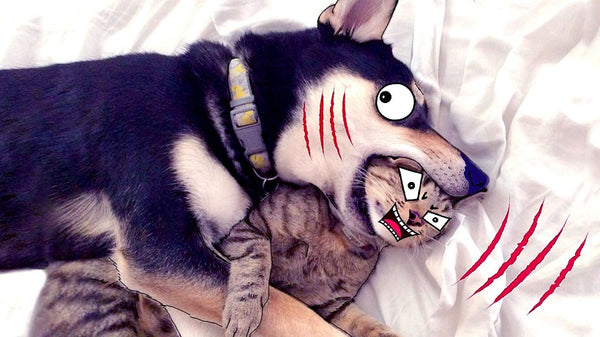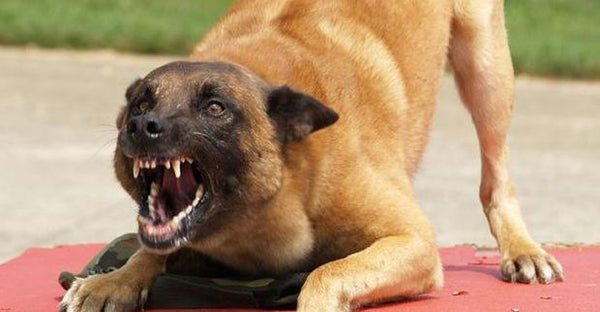Every dog is unique, with its own personality. Their mood varies from joy to fright. However, if your dog shows aggression to others or other dogs, you need to pay more attention. In this article, Happy & Polly will tell you why your dog is aggressive and how to stop their aggression.

When your dog frequently snaps, growls or bites, you need to pay more attention. Dog aggression can lead to injuries to dogs or people. And not only are large dogs and "dangerous dog breeds" are easily become aggressive; any breed pick up aggressive behavior under some circumstances.
Signs of Dog Aggression

A Dog’s aggressive behaviors may include:
- Licking lips or yawning
- Quickly swinging tail and a sturdy body
- Tail squat between the legs
- Avoid staring
- Fur Raise
- Cringe and folding tail
- See eyes' whites
- Growl and snapping warning
Some signs may indicate aggression, while others may indicate fear or anxiety. When you discover these signs, you will need to consult your vet first. The first step in stopping this behavior is to figure out what caused the dog's attack.
Causes of aggression in dogs
Dog aggressive behavior refers to any behavior related to an attack or an upcoming attack. This includes becoming still, stiff, roaring, growling, baring teeth, lunging or biting.

It does not have to be directed at a person. Some dogs will attack other animals, such as cats, or inanimate objects such as wheels. Some dogs will growl as someone approaches when. Others react to strangers.
There are several types of dog aggression you can refer to:
- Fear aggression- The most common reason for dogs to attack others is fear. These behaviors usually occur due to lack of proper social interaction, past negative experiences, or abuse by owners. The dog is scared and tries to retreat in terrible situations, but will attack when cornered.
- Territorial aggression- Territorial aggression occurs when a dog is highly aroused by the presence of a stranger or a dog approaching his property. When your dog thinks there is an intruder to his space, he may behave aggressively to defend the space.
- Anxiety aggression- Recent changes in a dog’s environment, such as arrival of a new member, or changing to a different place, might be making them anxious, causing them to exhibit aggressive behaviors.
- Social aggression- Social aggression is a dogs’ natural behavior, much of which stems from instinct passed down from generation to generation. Dogs respond aggressively to other dogs in social situations. Not all dogs are socially aggressive.
- Leash Aggression- When some dogs are put on a leash, they start to bark, lung or snap at anything or anyone they see. These are leash-aggressive behaviors. It is mainly because they feel too restrained by one string.
- Protective aggression- This usually happens to mom dogs. They show aggressive behaviors to protect their own puppies when anyone or any animal comes near them.
- Redirected aggression- This is the frustration caused by the dog not being able to achieve what they need. The dog will eliminate frustration in other ways, such as attacking another pet or even a human.
- Pain & Illness aggression- When a dog is injured or in pain, they might show aggressive behaviors. Some diseases can also make a dog aggressive.
- Other causes- such as possessive or resource guarding, defensive aggression, sex-related aggression or predatory aggression.
It is important to remember that only when you find out the reason, you can come up with a plan to stop your dog’s aggression.
How to Stop Dog Aggression?
Note when your dog becomes aggressive and the environment around it. This will play an important role in determining the cause and solution. All the behaviors are only different symptoms of an underlying problem.

You may need time, consistency, and professional help. Here are the tips:
- Consult Your Vet
When a suddenly exhibits aggressive behavior, it may have potential medical problems. You should contact your vet to help you identify whether your dog is having a health issue. Health problems such as encephalitis, epilepsy, and brain tumors can cause aggression.
If your dog is having a health issue, medication or other medical treatment will help you stop your dog’s aggressive behavior.
- Consult a Dog Trainer
If it is not a health problem, you can go find a professional dog trainer or other professionals in animal behaviors. Aggression is a serious issue, you will need professional advice to help you determine the cause of your dog’s aggression and made a plan to solve it.
- Follow a Proper Training Plan
After the professional dog trainer help makes the best plan to manage a dog's attack, you will use positive reinforcement to teach the dog new behaviors.
If it is strangers that cause your dog’s aggression, you should first keep a distance from the ones your dog isn’t familiar with. When your dog stops growling, you can praise or reward your dog.
- Bite Resistant Dog Toy
Bite Resistant dog toy or dog chew is also a good way for dogs to relieve pressure and anxiety. When you have to keep your dog at home, toys can help eliminate boredom and provide comfort when they are nervous. Dogs are usually very happy to play with anything on which they can put their paws.

- No Punishment
Punishing a dog will not stop them from aggressive behaviors and may also backfire sometimes. If you hit or yell at them, they may defend themselves and bite you instead.
It may cause them to bite others. For instance, if you punish your dog for barking at a child, he might bite other children when they come near him.
- Medication Treatment
In some cases, we cannot rely on training alone. Dogs that are aggressive due to fear may need medication to help solve the problem. It is important to understand that dogs experiencing fear, stress or anxiety cannot learn new things. Medication can better help your dog overcome this fear. You can consult your vet for this.
We hope this can help you train your dog. If you enjoyed it and would like to see more news, do not hesitate to visit Happy & Polly website on https://happyandpolly.com.

